Related Research Articles
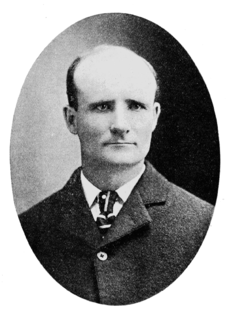
John Bell Hatcher was an American paleontologist and fossil hunter known as the "king of collectors" and best known for discovering Torosaurus and Triceratops , two genera of dinosaurs described by Othniel Charles Marsh. He was part of a new, professional middle class in American science, having financed his education with his labor while also being more educated than older fossil collectors. As such, he faced unique challenges throughout his long and productive career.

Othniel Charles Marsh was an American professor of Paleontology in Yale College and President of the National Academy of Sciences. He was one of the preeminent scientists in the field of paleontology. Among his legacies are the discovery or description of dozens of new species and theories on the origins of birds.
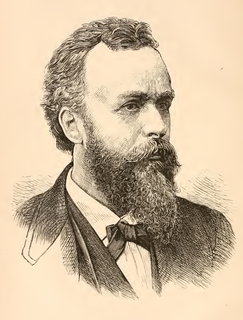
Edward Sylvester Morse was an American zoologist, archaeologist, and orientalist. He is considered the "Father of Japanese archaeology."
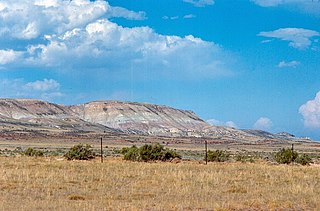
Como Bluff is a long ridge extending east-west, located between the towns of Rock River and Medicine Bow, Wyoming. The ridge is an anticline, formed as a result of compressional geological folding. Three geological formations, the Sundance, the Morrison, and the Cloverly Formations, containing fossil remains from the Late Jurassic of the Mesozoic Era are exposed. Nineteenth century paleontologists discovered many well-preserved specimens of dinosaurs, as well as mammals, turtles, crocodilians, and fish from the Morrison Formation. Because of this, Como Bluff is considered to be one of the major sites for the early discovery of dinosaur remains. Among the species discovered is the only known specimen of Coelurus. Significant discoveries were made in 22 different areas scattered along the entire length of the ridge. It is included on the National Register of Historic Places as well as the National Natural Landmark list.
Leo George Hertlein was an American paleontologist and malacologist who studied the Recent and fossil mollusks of the eastern Pacific Ocean.

Charles Robert Knight was an American wildlife and paleoartist best known for his detailed paintings of dinosaurs and other prehistoric animals. His works have been reproduced in many books and are currently on display at several major museums in the United States.
Dolerorthis is an extinct genus of hesperorthid brachiopod. The type species of this genus, D. interplicata, was described from the Silurian (Telychian) Osgood Formation. Other species belonging to this genus are known from the Ordovician and Silurian of Europe, Kazakhstan, China and Argentina. It was roughly 4 centimetres (1.6 in) across.

Charles Whitney Gilmore was an American paleontologist who gained renown in the early 20th century for his work on vertebrate fossils during his career at the United States National Museum. Gilmore named many dinosaurs in North America and Mongolia, including the Cretaceous sauropod Alamosaurus, Alectrosaurus, Archaeornithomimus, Bactrosaurus, Brachyceratops, Chirostenotes, Mongolosaurus, Parrosaurus, Pinacosaurus, Styracosaurus ovatus and Thescelosaurus.
Charles Schuchert was an American invertebrate paleontologist who was a leader in the development of paleogeography, the study of the distribution of lands and seas in the geological past.
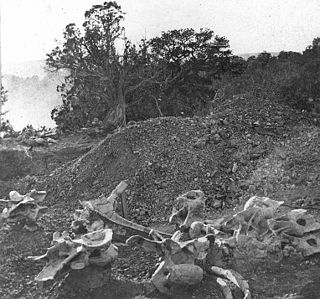
Garden Park is a paleontological site in Fremont County, Colorado, known for its Jurassic dinosaurs and the role the specimens played in the infamous Bone Wars of the late 19th century. Located 10 km (6.2 mi) north of Cañon City, the name originates from the area providing vegetables to the miners at nearby Cripple Creek in the 19th century. Garden Park proper is a triangular valley surrounded by cliffs on the southeast and southwest and by mountains to the north; however, the name is also refers to the dinosaur sites on top and along the cliffs. The dinosaur sites now form the Garden Park Paleontological Resource Area, which is overseen by the Bureau of Land Management.

Charles Emerson Beecher was an American paleontologist most famous for the thorough excavation, preparation and study of trilobite ventral anatomy from specimens collected at Beecher's Trilobite Bed. Beecher was rapidly promoted at Yale Peabody Museum, eventually rising to head that institution.
"Quiet, unassuming, modest in a very marked degree, simple, without affectation, entirely free from all eccentricities, conscientious and painstaking in every thing he had to do. In the words of Professor Chittenden, Director of the Sheffield Scientific School '.. .. to those who knew Professor Beecher intimately no words of appreciation will be deemed too extravagant, for close association only brought more clearly to view the many mental traits that testified to the strength of character and of mind that helped to make Professor Beecher one of the strong men of the Scientific School.' "

Gigantoproductus is a genus of extinct brachiopods in the order Productida and the family Monticuliferidae. The species were the largest of the carboniferous brachiopods, with the largest known species ranging in size from 9 to 12 centimeters. The earliest members of the Productida date back to the Silurian period, and Gigantoproductus is known to have existed between 339.4 to 318.1 million years ago, during the Carboniferous period. As fossils, their shells occur within a limestone matrix.
Carl Owen Dunbar was an American paleontologist who specialized in invertebrate fossils. He was a Professor of Geology at Yale University from 1920 until 1959. He was also Director of the Peabody Museum of Natural History at Yale University from 1942 until 1959. As editor of a textbook series on historical geology from the 1920s through the 1950s, his work was published and sold in over 1 million books.

Crania is an extinct genus of brachiopods that lived during the Upper Cretaceous.

Paleontology in Ohio refers to paleontological research occurring within or conducted by people from the U.S. state of Ohio. Ohio is well known for having a great quantity and diversity of fossils preserved in its rocks. The state's fossil record begins early in the Paleozoic era, during the Cambrian period. Ohio was generally covered by seawater from that time on through the rest of the early Paleozoic. Local invertebrates included brachiopods, cephalopods, coral, graptolites, and trilobites. Vertebrates included bony fishes and sharks. The first land plants in the state grew during the Devonian. During the Carboniferous, Ohio became a more terrestrial environment with an increased diversity of plants that formed expansive swampy deltas. Amphibians and reptiles began to inhabit the state at this time, and remained present into the ensuing Permian. A gap in the local rock record spans from this point until the start of the Pleistocene. During the Ice Age, Ohio was home to giant beavers, humans, mammoths, and mastodons. Paleo-Indians collected fossils that were later incorporated into their mounds. Ohio has been the birthplace of many world famous paleontologists, like Charles Schuchert. Many significant fossils curated by museums in Europe and the United States were found in Ohio. Major local fossil discoveries include the 1965 discovery of more than 50,000 Devonian fish fossils in Cuyahoga County. The Ordovician trilobite Isotelus maximus is the Ohio state invertebrate fossil.
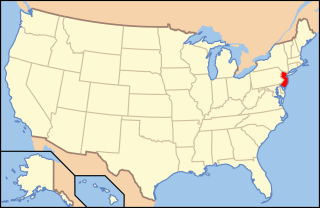
Paleontology in New Jersey refers to paleontological research in the US state of New Jersey. The state is especially rich in marine deposits.

Paleontology in Massachusetts refers to paleontological research occurring within or conducted by people from the U.S. state of Massachusetts. The fossil record of Massachusetts is very similar to that of neighboring Connecticut. During the early part of the Paleozoic era, Massachusetts was covered by a warm shallow sea, where brachiopods and trilobites would come to live. No Carboniferous or Permian fossils are known from the state. During the Cretaceous period the area now occupied by the Elizabeth Islands and Martha's Vineyard were a coastal plain vegetated by flowers and pine trees at the edge of a shallow sea. No rocks are known of Paleogene or early Neogene age in the state, but during the Pleistocene evidence indicates that the state was subject to glacial activity and home to mastodons. The local fossil theropod footprints of Massachusetts may have been at least a partial inspiration for the Tuscarora legend of the Mosquito Monster or Great Mosquito in New York. Local fossils had already caught the attention of scientists by 1802 when dinosaur footprints were discovered in the state. Other notable discoveries include some of the first known fossil of primitive sauropodomorphs and Podokesaurus. Dinosaur tracks are the Massachusetts state fossil.
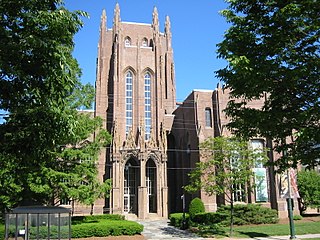
The Peabody Museum of Natural History at Yale University is among the oldest, largest, and most prolific university natural history museums in the world. It was founded by the philanthropist George Peabody in 1866 at the behest of his nephew Othniel Charles Marsh, the early paleontologist. Most known to the public for its Great Hall of Dinosaurs, which includes a mounted juvenile Brontosaurus and the 110-foot-long (34 m) mural The Age of Reptiles, it also has permanent exhibits dedicated to human and mammal evolution; wildlife dioramas; Egyptian artifacts; and the birds, minerals and Native Americans of Connecticut.
Rhynchospira globosa is a Paleozoic articulate brachiopod of the Athyridida. It was discovered in 1857 by James Hall.
References
- ↑ "Camarotoechia contracta Hall, 1843". Yale Peabody Museum of Natural History. Retrieved 29 November 2018.
- ↑ "Camarotoechia contracta; YPM IP 327197; North America; USA; Pennsylvania; Warren County; Warren". Discover Yale Digital Content. Retrieved 29 November 2018.
- ↑ Schuchert, Charles (1897). A Synopsis of American Fossil Brachiopoda including Biography and Synonymy. Washington D.C. United States: Washington Government Printing Office. Retrieved 5 December 2018.
- ↑ "Camarotoechia contracta Hall, 1843". Yale Peabody Museum of Natural History. Retrieved 29 November 2018.